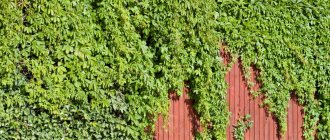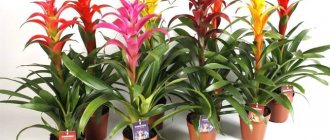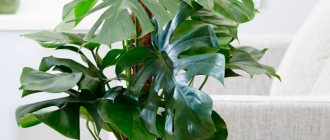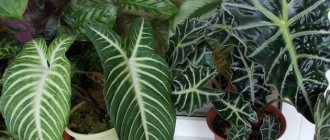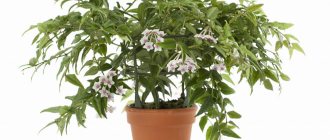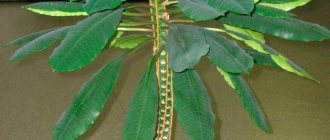Cissus
The vine of the Grape family is distinguished by its high growth rate and unpretentiousness.
The absence of sudden changes in room temperature and sufficient humidity are important for large green mass.
From an environmental point of view, cissus is very useful in the home: it releases phytoncides that help cleanse the air of pathogens. But popular superstitions attribute to him the ability to drive husbands out of the house.
Folk signs
People have long noticed the relationship between their favorite plants and fate. Here are the main superstitions:
- Evergreen ivy pushes representatives of the male half of humanity out of the house. The husband will leave, the son will leave. And my daughter won’t have a betrothed.
- The cactus makes girls “prickly” for potential suitors. No one will stay until the desired wedding. And the existing spouse will start drinking heavily.
- Mother-in-law's tongue (pike tail) takes away femininity. The hostess becomes masculine. Naturally, fate also changes. You will have to carry all the problems on your shoulders.
- The palm tree will make the atmosphere sad and painful. Divorce is near.
Zephyranthes will contribute to a clash of egos between the spouses. An upstart (another name) provokes irreconcilable conflicts. Under his influence, a woman becomes unyielding, and a man becomes rude. It also attracts need.
Eschynanthus
Aeschynanthus is an epiphyte of the Gesneriaceae family, called “fondant” for its bright flowers of an unusual inverted shape. The capricious and demanding plant is grown using the hanging method; to gain green mass, it is worth planting several cuttings in one pot.
Afraid of direct sunlight, shade, sudden temperature changes and waterlogging.
It has a controversial reputation: along with the ability to improve the atmosphere, purify the air and simply decorate the house, it is credited with the same “husband-driver” properties as cissus.
Features of care
The main advantage of syngonium is its unpretentiousness. It quickly adapts to various conditions and has a high survival rate. Another aspect why gardeners love it so much is the rapid growth of this vine.
Air temperature
A comfortable temperature range will be 18-24° C, in winter, lower it to 17-18° C. It is possible to briefly reduce the temperature to a maximum of +10° C.
Watering and air humidity
In the warm season, abundant, but without stagnant, moisture in the pot is needed. Water as soon as the top layer of soil dries out. Drain excess water from the pan. In winter, when wintering is cool, it should be watered after the earthen clod has dried by 1-2 cm.
Liana prefers moderate air humidity. On hot days, spray the plant daily, sometimes wipe the leaves with a damp sponge. In winter, place away from heating systems. Spraying may not be necessary, but then from time to time place the plant on a tray with damp expanded clay, pebbles, and moss.
Water and spray the syngonium with softened water at room temperature.
Transfer
How to replant syngonium photo
Young vines (up to 3 years old) require replanting annually in the spring. In the future, replant every 2-3 years.
The soil must be loose, nutritious, with a neutral or slightly acidic reaction. If possible, prepare the soil mixture: take 1 part of leaf soil, turf soil, peat, add 0.5 parts of sand. Can grow hydroponically.
The container is wide and shallow. With each transplant, increase its volume slightly.
Bloom
As a rule, this plant does not bloom when grown indoors. But if it does bloom, the flower will be represented by a not very large cob, which is wrapped in a white blanket.
Air humidity
In the hot season, it is recommended to moisten the foliage regularly twice a day in the evening and morning. And to remove dust from the foliage, wipe it regularly with a damp sponge. In order to increase the level of air humidity, pour moistened expanded clay or peat into the tray and place the container with the plant on it, but the water should not touch its bottom. Under no circumstances place the flower near heating appliances.
Garter creeper
Create a support for ampelous varieties to increase decorativeness. A moss pipe works well. It is placed in the center of the pot during transplantation. It is necessary to lay a drainage layer consisting of expanded clay, clay shards and other similar materials. Then place the tube, add a third of the soil, place the plant, add soil in a circle, pressing lightly.
Feeding and pinching
Fertilizers should be applied in spring and summer. Every 2-3 weeks, feed with mineral fertilizers in liquid form.
To increase bushiness, you should pinch out the apical shoots above the 6-7th leaf.
Optimal conditions of detention
The best temperature for maintaining a flower in proper form is +22…+25°C. In winter, it is quite acceptable to warm the air in the room only to +18°C.
You can trim the vine after it produces the first 3 leaves. If necessary, any shoot must be pinched, since syngonium is absolutely not afraid of this procedure. It is especially useful to do this if the stem has become old or has dropped its leaves, then such manipulation will contribute to the formation of new shoots.
Important! Lighting for a flower should not be too strong. It is necessary to provide it with diffused light, since direct sunlight can leave burns on delicate leaves.
Ivy evergreen
Hedera is the second name of this plant of the Araliaceae family. It has a lot of useful properties and is used in medicine as an anti-inflammatory, antitussive, and healing agent.
At home, it needs diffused lighting, high humidity, spraying, and a shower.
It is credited with calming properties, the ability to neutralize negative energy, and purify the air. It is believed that single girls and young families need to have a plant. And adult ivy drives suitors away from the house and drives away husbands.
Besides climbing plants, what other indoor flowers cannot be kept in the house?
This is very important to know because some species pose a major threat to human and animal health.
- All plants of the Euphorbiaceae, Solanaceae, Araceae, Araliaceae families, all varieties and types of lilies, rhododendrons and azaleas are not recommended to be kept indoors.
- What indoor plants are low toxic? This group consists of indoor flowers of the Amaryllis family - aloe, geranium, dracaena, yucca, Kalanchoe, amaryllis, clivia, etc.
- Which indoor plants are safe? Currently, there are many homemade flowers that are absolutely safe for human life and health. For example, Uzumbara violets, orchids, gloxinias, various types of succulents, hibiscus, etc.
Philodendron
An evergreen plant of the Araceae family, it is popular as an indoor flower. Can be grown in hanging pots or on a support. Loves humidity and warmth, is not afraid of shade, and grows quickly.
According to signs, unmarried people should not have it - it will discourage suitors, and it should also be used with caution by married couples, since it encourages men to leave the family.
But if these are just signs, then the poisonous sap of the plant is definitely an important factor that is worth thinking about, especially if there are small children in the house.
Popular beliefs
The signs associated with this plant are both positive and negative, some of them promise well-being in the family, while others warn: the flower has negative energy. The most popular types of plants (footed, pink, brocanthus, confetti) are associated with the same legends and superstitions.
Positive
- During its life, the plant transforms, and similarly the people around it transform: skeptics and conservatives begin to look at the world from a new angle, not being afraid to try something new and previously unknown.
- If a person is far from a conservative and not at all a skeptic, but dreams of burning all the bridges behind him and starting a new life, it’s time to think about purchasing a syngonium. It is believed that this particular vine can relieve the burden of the past.
- Finding a place in your home for a plant is also necessary for those who are often sick. Some beliefs say that the flower repels diseases.
- Those who suffer from nightmares should also think about purchasing syngonium. It is believed that if you place this amazing plant in your room, bad dreams will bypass you.
- Insecure people who struggle with indecision would do well to place a pot of syngonium in their home. Some beliefs say that the plant can really help people establish and maintain social connections.
- Good news for anyone learning something new: having this green companion at home is believed to help improve learning. It is not surprising that students are happy to plant this flower in their homes, because it requires minimal care.
Negative
Syngonium is really beautiful and quite picky, so what stops gardeners from adding it to their green collection? In addition to favorable beliefs, the plant has also gathered negative superstitions that force amateur gardeners to abandon the idea of having a flower at home.
It is believed that syngonium is capable of expelling men from the house . However, many indoor vine plants have received the same notoriety. Regulars of various forums about house plants speak out in defense of syngonium; many refute this prejudice and say that the men from their families are in no hurry to leave.
Tradescantia
Perennial herbaceous plant of the Commelinaceae family. It has an unusual striped color and is grown using the hanging method. Requires diffused light, regular watering, and tolerates low humidity well.
It is believed that Tradescantia absorbs electromagnetic radiation, negativity, and anger.
If suddenly a plant dies, you should not just throw it out, but bury it away from the house - many believe that it has absorbed bad energy. At the same time, there is an opinion that it also has a bad influence - it makes a person absent-minded, forgetful, and inattentive.
Source
Is a vine in the house useful according to Feng Shui or not?
According to the ancient teachings of Feng Shui, in order for there to be harmony in the house, and for all household members to be successful in all areas of life, it is necessary that all the elements in the house are in harmony with each other, and that energy flows have a beneficial effect on a person and the sphere of his life, pulling him towards great achievements.
Correctly adjusting the energy is a real art that has been developing over many centuries and bears the world-famous name - Feng Shui. The Feng Shui system takes into account a lot of elements and when creating the right living space, everything is important, from the location of the house to the shape of the rooms, their furnishings and decorative elements. One of the important elements in any home are indoor plants, which can both improve the situation with energies in the house and, on the contrary, attract various troubles and failures.
On the one hand, indoor plants make a living space more vibrant, filled with light and warmth, they can soften the influence of energy coming from outside through windows and even absorb negative energy.
On the other hand, the choice of plants must be approached with the utmost care. Some plants can be harmful if placed incorrectly indoors.
When choosing a plant for your home, its size, leaf shape and even flower color are important.
During the flowering period, the liana becomes even more dangerous, if you believe the teachings of Feng Shui, since a flowering liana can completely block male sexual energy, leading to discord in the intimate life of spouses. As a rule, vines do not bloom often, so not everyone knows that they throw out a small, unassuming flower.
During the flowering period, a liana can make a man sexually passive, and in addition, cause serious quarrels between spouses. Indoor vines can completely destroy the energy flows in the house, causing an energy imbalance. Particularly dangerous are those vines that fall down; such plants are capable of sucking out positive energy.
In principle, these plants work as “energy plants”, and the vines are capable of creating flows through which positive energy does not accumulate in certain rooms, but rather disappears and dissipates. Since indoor vines are quite tenacious plants, it is believed that this plant owes its vitality precisely to the energy absorbed by the plant. In addition, all vines have a specific leaf shape that is completely inconsistent with Feng Shui criteria.
According to Feng Shui, indoor plants should have round or pointed leaves with white or red flowers, in this case the plants will be a kind of filter for negative energy and an accumulator of positive energy. Plants that meet the requirements of Feng Shui can reduce the outflow of positive energy in places where this outflow is possible.
Indoor vines and all climbing plants are a symbol of loneliness, so if this plant is in the bedroom, it leads to discord in family life. It is believed that vines seem to envelop all spheres of a person’s life, not giving them access to energy, as if suffocating them; perhaps these associations appeared due to some similarity of this creeping plant with a snake.
Most feng shui experts agree that vines in the home are a negative thing, but there are some loopholes where vines can be of benefit to home owners.
Lianas can be a kind of indicator of well-being in the house. Creepers are good to have in the house for those who cannot find the reason for their failures, although all the cards are in the person’s hands. Perhaps it is precisely the existing imbalance of energy in the house. Lianas in such an environment become sick, lethargic, their leaves quickly turn yellow, and growth slows down. The deterioration of the vine’s condition clearly reflects the deterioration of the energy state in the house. Lianas are often placed in rooms where water energy predominates, since this plant is able to compensate for water energy; in this case, the vines are placed in such a way that their branches stretch upward.
In addition, there are so-called “dead corners” in some houses; it is in these energy zones that the vine will come in handy, as it can completely block the flow of negative energy in such a place. In “dead zones”, vines should be positioned so that the branches fall down, so that negative energy will go into the ground and not dissipate throughout the room. The properties of plants according to the teachings of Feng Shui can vary depending on the type of plant, their shape and size, and direction of growth.
Properly placed plants in the home can greatly improve the well-being of the family. Plants located on window sills and in corners can protect against negative energy, but the choice of plants must be approached responsibly and knowledgeably.
If you want to attract love and happiness in family life, some plants are suitable, for example, cyclamen, begonia, amaryllis adiantum camellia; for success you need other plants, and others for career growth.
Lianas are among those plants that are still not very suitable for keeping in the house, because finding the right place for this plant is difficult even for many professionals, not to mention amateurs.
Did you like the article? Subscribe to the channel to stay up to date with the most interesting materials
Source
Most popular types
Tradescantia
Stress-resistant, unpretentious flower. Decorative leaves of various colors are something incredible. With good care, tradescantia can bloom. Its small flowers resemble daffodils in appearance. This plant loves good lighting with protection from the scorching sun. In partial shade, Tradescantia loses its decorative qualities - the variegated leaves acquire a uniform color, and the shoots stop growing and become lethargic. This flower responds well to frequent watering and spraying.
Scindapsus
A unique decorative foliage plant that can grow in any corner of the house. This heart-shaped flower with glossy leaves of bright green or variegated colors grows very quickly. Climbing the wall, this ampel can reach a meter in height. Shade-loving and low-maintenance scindapsus require stimulating pruning, after which they form a dense crown of numerous young shoots. After this, scindapsus looks lush and spectacular.
Saxifraga shoot
A miniature plant with thin shoots hanging down to the bottom. At the age of 3, this plant produces a long peduncle, on which small white or pink flowers are formed, collected in a corymb inflorescence. Saxifraga flowers are not particularly decorative or attractive; moreover, they take away all the strength and energy from the plant. Therefore, the flower arrow is pinched even before it blooms. Saxifragas are shade-loving indoor plants, so they can be kept in any corner of the house.
Philodendron climbing
An unpretentious perennial with leaves similar to the shape of scindapsus leaves. Philodendron leaves have a rich green color, with a burgundy shade on the underside of the leaf blade. The surface of the leaves is leathery, glossy, and heart-shaped.
Ivy
This is perhaps the most common inhabitant of residential buildings and apartments. Ivy grows quickly, deftly clinging to vertical surfaces with its sucker roots. These are unpretentious, shade-loving flowers that belong to the group of solid dark green plants.
Variegated ivy varieties are capricious species that require bright, indirect light with protection from direct sunlight. These flowers do not need high air humidity, and they respond quite well to periodic spraying of leaves and shoots.
Cissus or indoor birch
Decorative deciduous climbing perennial. It deftly clings to any support with the help of its antennae. Despite the fact that this is a shade-tolerant indoor flower, it grows best on the south side of the house, where there is good light. In summer and spring, cissus loves frequent watering and spraying.
Hoya
One of the most elegant indoor vines. Blooming wax ivy dilutes the pleasant aroma. Flowers in the shape of a five-pointed star come in a wide variety of colors - snow-white, soft pink, yellow, purple, depending on the variety. Despite the fact that these are unpretentious plants, they require certain conditions for full growth and flowering: bright diffused light, systematic watering in the summer and moderate soil moisture in the winter. During the flowering period, hoya should not be disturbed, otherwise its flower buds will wither and fall off.
Ficus creeping
An unpretentious plant in lighting that can grow in any corner of a house or apartment. This is a moisture-loving flower, so it needs frequent watering. Due to lack of moisture, the dark green, succulent leaves of ficus lose their decorative effect. Shade-loving creeping ficuses are used for landscaping residential buildings, apartments and offices.
Ampelous begonia
A charming decorative flowering climbing plant that does not have any special care requirements. This species is valued by many gardeners for its long and abundant flowering, which can only be achieved in conditions of high-quality lighting. In spring and summer, this flower is watered often and abundantly; in winter, watering is reduced. Modern selection has developed new hybrid varieties of begonia with semi-double and double flowers of a wide variety of colors. Unpretentious in care, climbing begonias are readily used in landscaping home interiors. They are planted in hanging pots, flowerpots and baskets.
Campanula equifolia
A delicate, medium-sized plant with thin hanging shoots up to 30 cm long. In bright light, it blooms profusely with white and light lilac bell flowers 3-5 cm in diameter. From early spring to late autumn, this plant needs frequent watering. The bell loves fresh air, so in the summer it is taken outside or onto the balcony.
Golden mustache
A liana-like herbaceous plant reaching a height of 1 m at home. It blooms with small fragrant flowers located on hanging shoots. The leaves are wide, large, and somewhat similar in appearance to corn leaves. This plant has healing properties, so it is grown not only for decorative, but also for medicinal purposes.
Morning glory or loach
A capricious hanging plant that needs high air humidity, does not like drafts and sudden temperature changes. It blooms with pale blue funnel-shaped flowers, arranged singly. This indoor vine goes very well in plantings with other large-flowered plants.
These hanging plants can be kept in the apartment. They are great for interior landscaping, making it lively and original.
Why are people afraid of climbing plants?
One of the common reasons for the appearance of superstitions is negative associations of harmless objects with downright dangerous ones. The long curving lashes of vines quite obviously resemble snakes, worms and other creeping things that are not very pleasant to humans, and sometimes life-threatening. The snake, in addition to the fact that it can be poisonous, is also the personification of vice, temptation, and cunning for Christians . Hence the superstition: vines in the house - to quarrels, the appearance of a “homewrecker snake” (mistress), a man leaving the family, a loss of interest between spouses in each other.
Another associative connection - ropes, shackles, noose - is also unpleasant. Based on this image, fear of illness and bodily injury arose. Due to the appearance of climbing plants in the house, superstitious mothers begin to fear “suffocation”, sudden infant death, and pregnant women begin to fear a difficult birth due to the umbilical cord entwining the baby’s neck.
By the way, Feng Shui treats vines only positively. Climbing plants reflect negative energy (the so-called “poisonous arrows of sha-qi”), and also create a curtain around unfavorable areas that softens their impact on the residents of the house, says the teaching.
The real danger of indoor vines
Looked at objectively, superstitions are negative attitudes. At one time in the past they may have had a rational basis, but today they are largely groundless. If a negative influence exists, then it usually lies on a completely different plane. So, climbing plants in the house can be dangerous if:
From an environmental point of view, many indoor vines, especially ivy and tradescantia, are excellent absorbers of formaldehyde and other unfavorable compounds released into the air by furnishings, and today it is so difficult to find something 100% environmentally friendly.
In my family and friends, climbing plants do not cause any concern. They perfectly decorate a room, fill empty walls, and watching how they are positioned and what their shoots grab onto is a kind of anti-stress. As a child, I was very surprised by ivy: “Well, how long will this endless flower grow?” Now my favorite is Tradescantia: it is unpretentious, non-poisonous, grows quickly, and the striped leaves look very decorative!
Photo gallery: popular indoor climbing plants
You cannot tell yourself not to be superstitious. If the article does not convince you that the beliefs are groundless, and after hearing a sign regarding a plant in your home, you begin to look at it with suspicion and worry - give it to someone who does not experience such emotions. If you still feel comfortable surrounded by indoor vines, great, let them make you happy too. But do not forget about the safety rules mentioned.
Source
Recommended for growing
Many housewives are happy to grow climbing indoor plants, as they can not only complement the interior, but also transform it. And so that the plant does not fade and delights with its beautiful appearance all year round, you need to know what features characterize this or that flower, as well as what conditions it will need to be created.
Graceful hoya vines
Hoya can easily be called the most elegant indoor flower in the liana category.
Flowering ivies are quite attractive and also have a pleasant, unobtrusive aroma. The hoya vine is decorated with beautiful flowers, shaped like five-pointed stars with colors ranging from snow-white to purple (depending on which variety will be grown indoors). These beautifully flowering plants are unpretentious, although they require the creation of certain conditions. First of all, such plants require bright but diffused lighting, as well as systematic watering (regular in the mornings in the summer and moderate in the winter). In addition, the plant should not be disturbed during its flowering period. Otherwise, the buds will quickly wither and then fall off.
Hoya does not grow quickly and therefore does not require frequent replanting. This tempts many housewives who want to keep a beautiful vine with fragrant flowers in their home without putting much effort into caring for it.
Monstera Queen
This is perhaps the most common indoor flower in indoor floriculture. In its natural environment, the montera can reach several meters in length. At home, its vines grow more slowly and therefore rarely reach their natural length. Monsteras, like hoyas, are unpretentious plants. However, unlike the latter, monsters are not shade-loving. For full growth and flowering, they require bright lighting without direct sunlight.
Dipladenia or mandevilla
This climbing flower is not as popular as its predecessors. Blooming mainly in the summer, mandevilla will decorate any interior. Its inflorescences can be white, pink or red, which will depend on the variety chosen for cultivation. This is a fast-growing climbing plant whose stems constantly shoot upward. Therefore, it cannot be grown in hanging pots. Given the rapid growth of mandevilla vines, it will be necessary to provide it with regular watering and good lighting. In order for the plant to fully develop and delight its owners, it will also need to be provided with an optimal temperature regime, close to the conditions of the natural environment.
"Indoor grapes" - cissus
The official name of this climbing indoor plant is cissus antarcticus, although it is popularly called ivy or indoor grapes.
Its natural habitat is the lands of Australia. Today there are many people who want to keep such a flower at home. And it’s not surprising, because he is unpretentious and very handsome. Cissus are shade-loving plants, although they can be grown freely in well-lit rooms. There are also no special requirements for growing such indoor flowers in terms of temperature conditions - they can grow both in warm and cool rooms.
The only rule that must be followed when organizing the care of cissus is timely watering. The soil should not be allowed to dry out. It is also recommended to replant the plant annually in a larger pot. Transplantation of cissus plants, as a rule, should be done in the spring.
This plant can be considered universal. It can be grown as an ampel flower, in hanging pots. In this case, the cascading stems of the shoots will look especially impressive in tall pots on a stand. Cissus is also grown like a vine - its shoots can be directed upward so that they entwine a support. For this option, decorative ladders are suitable, along which the stems will tend upward.
Miniature saxifrage
Saxifraga is a very impressive miniature indoor plant, the thin shoots of which hang down. Having reached the age of 3 years, shade-loving saxifrages are able to please their owners with beautiful inflorescences resembling a shield.
Like previous types of climbing indoor plants, saxifrage does not require care. They can be grown in any conditions, which increases the interest of those who want to keep an unpretentious climbing flower in their home.
Loach flower home signs
Useful on the topic: “House loach flower signs” with comments from our professionals. If you have any questions as you read, leave them in the comments to the article.
Most likely, you know that growing climbing flowers and vines in some way prevents you from living with a man under the same roof. Such plants include: ivy, tradescantia, epipremnum, golden mustache, however, here too there are nuances and interesting points. Let's try to figure out which flowers should not be kept at home and why.
Varieties of indoor flowers and their features
If we take specifically the type of climbing plants, it will be represented by two varieties:
- Lianas are stems that grow upward, clinging to a support and entwining it. The tropics are considered the homeland of such plants, where vines can easily entwine trees and shrubs. The most striking representatives of this type of plants that can be kept at home are monstera, mandevilla, hoya, morning glory, etc.
- Hanging plants are plants that are planted in hanging pots. The young stem first grows upward, and then, lengthening, begins to descend to the ground, hanging beautifully from the pot. Among such plants, the most common are ampelous petunia, indoor jasmine, tradescantia, dichondra and others. Representatives of this species are unpretentious in care and at the same time very impressive, although they do not bloom.
At the same time, some of the famous flowers cannot be kept in a residential area, because they pose a threat to human health and are also dangerous to animals. It is especially important for those who have small children to know which climbing indoor plants cannot be grown in their home.
If we talk about what types of climbing flowers are not recommended for indoor growing, then these are:
Among other plants, whose presence in an apartment or house is fraught with adverse consequences:
- representatives of the families Aroidaceae, Euphorbiaceae, Solanaceae, Araliaceae;
- all varieties of lilies and azaleas;
- rhododendrons.
There are also plants that cannot be grown for other reasons (according to popular beliefs). For example, the golden mustache plant is given the ability to drive men out of the house. At the same time, scientists claim that this plant can, on the contrary, improve the home atmosphere. The same plants include shade-loving hanging flowers and varieties of ivy. Moreover, such green pets are strongly recommended to be raised indoors, as they can not only purify the air in the room, but also clear it of unfavorable energy.
Another variety of hanging flowers that supposedly should not be kept in the house is considered to be tradescantia. These ampelous, shade-loving plants are considered medicinal, as they contain a whole complex of nutrients and medicinal elements. In addition, they are unpretentious in care and very impressive in appearance.
What plants should not be kept at home and why?
Based on the rules and technologies of the teachings of Feng Shui, vines, ivy, and other vines can protect a home. Reflect negative energy, drive away negativity in the form of poisonous sha-qi arrows, which are always directed in one direction and emitted by objects in the apartment. The capabilities of curly helpers also include compensation for unwanted energy in the form of a “curtain” of your home.
Although from the point of view of science, loaches help purify the air. Apparently you shouldn’t be so categorical about climbing plants. Although, now you know why you can’t keep climbing plants at home.
It is not known where the distrust of Tradescantia came from, a beautiful and quite common plant that supposedly “drives away” the male sex, but it also symbolizes prosperity and well-being.
The flower has incredibly sensitive energy, it is susceptible to any changes in the house, such a green indicator that allows you to identify the presence of problems in the apartment or the unsatisfactory state, both emotional and physical, of family members. If a flower reveals such energy, it withers, withers, dries up, and the leaves lose their vitality. If everything is fine in the house, you will be provided with a charge of positive energy.
Which pets should not be at home based on the teachings of Feng Shui?
According to the principles of ancient science, cacti are prohibited from being in the house. Many people believe that it is not safe to have poisonous flowers in the house; without having a Feng Shui consultant among your friends, it is impossible to get a clear answer.
Is the presence of cacti in a living space necessary or harmful? There is no categorical ban on Feng Shui, but some caution should be taken not to place “thorns” and their relatives near bedrooms, lounges and children's rooms. They talk about their predisposition (thanks to the thorns) to contribute to scandals and squabbles, the ability to make a person aggressive and hot-tempered. But in relation to the office, kitchen, corridor - there are no such prohibitions, you can freely place prickly friends to repel negative energy.
Today, scientists have confidently stated that the cactus has nothing to do with the absorption of negative electromagnetic radiation (and not so long ago, every computer monitor certainly had a pot with a helper flower, and we sincerely believed that we were absolutely protected from any impact on the body ) that come from a television or computer screen. The presence of a cactus located in the office can help improve performance and brain activity, thereby extending the working day and increasing productivity.
However, if you are already married, are not superstitious, or do not want to get married in principle, definitely place cacti around the perimeter of the windowsill, because the same spines help reflect hostile energy.
It sometimes seems that there is at least one sign or superstition regarding literally every object or phenomenon. People are especially wary of what appears in their home. Thus, women who are more likely to be superstitious, before getting a new houseplant, often first check to see if there are any bad beliefs associated with it. And then the housewife learned the news: you can’t keep climbing plants at home, it’s a bad omen.
Why are people afraid of climbing plants?
One of the common reasons for the appearance of superstitions is negative associations of harmless objects with downright dangerous ones. The long curving lashes of vines quite obviously resemble snakes, worms and other creeping things that are not very pleasant to humans, and sometimes life-threatening. The snake, in addition to being poisonous, is also the personification of vice, temptation, and cunning for Christians. Hence the superstition: vines in the house - to quarrels, the appearance of a “homewrecker snake” (mistress), a man leaving the family, a loss of interest between spouses in each other.
Another associative connection - ropes, shackles, noose - is also unpleasant. Based on this image, fear of illness and bodily injury arose. Due to the appearance of climbing plants in the house, superstitious mothers begin to fear “suffocation”, sudden infant death, and pregnant women begin to fear a difficult birth due to the umbilical cord entwining the baby’s neck.
By the way, Feng Shui treats vines only positively. Climbing plants reflect negative energy (the so-called “poisonous arrows of sha-qi”), and also create a curtain around unfavorable areas that softens their impact on the residents of the house, says the teaching.
The real danger of indoor vines
Looked at objectively, superstitions are negative attitudes. At one time in the past they may have had a rational basis, but today they are largely groundless. If a negative influence exists, then it usually lies on a completely different plane. So, climbing plants in the house can be dangerous if:
From an environmental point of view, many indoor vines, especially ivy and tradescantia, are excellent absorbers of formaldehyde and other unfavorable compounds released into the air by furnishings, and today it is so difficult to find something 100% environmentally friendly.
In my family and friends, climbing plants do not cause any concern. They perfectly decorate a room, fill empty walls, and watching how they are positioned and what their shoots grab onto is a kind of anti-stress. As a child, I was very surprised by ivy: “Well, how long will this endless flower grow?” Now my favorite is Tradescantia: it is unpretentious, non-poisonous, grows quickly, and the striped leaves look very decorative!
Photo gallery: popular indoor climbing plants This type of tradescantia is simple and effective at the same time Passiflora (passion flower) is exactly the vine on which the fruit will be set after flowering; not every species has it edible Common ivy (hedera) is one of the most popular indoor climbing plants Syngonium loves grow in shaded places Stephanopsis, in addition to decorative leaves, also has beautiful flowers Scindapsus looks very fresh and gentle Thunbergia fragrant is more often grown in the garden, but many are not averse to taking it into the house Ficus creeping is unpretentious, but in insufficient light it throws out shoots devoid of leaves Philodendron climbing is shade-tolerant , will perfectly green the far corner of the room Hoya (wax ivy) blooms spectacularly, but during flowering does not tolerate rearrangements Cissus is nothing more than the popular “birch”, an unpretentious and fast-growing vine The flowering of aeschynanthus can be called an enchanting spectacle
You cannot tell yourself not to be superstitious. If the article does not convince you that the beliefs are groundless, and after hearing a sign regarding a plant in your home, you begin to look at it with suspicion and worry - give it to someone who does not experience such emotions. If you still feel comfortable surrounded by indoor vines, great, let them make you happy too. But do not forget about the safety rules mentioned.
You are wondering: the peaceful bindweed growing green on your windowsill is indoor ivy, is it possible to keep it in the house, after all, signs give the plant a bad reputation... But is this true? Is esotericists consider ivy good or bad, and is it worth throwing away this unpretentious “bush” if it has been “registered” in your home for several months?
List of flowers that should not be kept at home
The natural need to communicate with nature is satisfied by growing indoor plants, but this must be done competently, without complicating life for yourself and loved ones living under the same roof. Like pets, plants in the house are not a piece of furniture, but a living, breathing and feeling being, with a character, energy and mood that can “infect” those around them.
Content:
We follow the main rule
Whether we choose a travel companion for the rest of our lives or decide to buy a plant for the windowsill, in order not to make a mistake, we need to listen to our own feelings, first of all, and understand our state of mind at the same time. Eye contact in the first minutes of communication will tell us whether we like what we see. And then you should connect your intuition, capturing the energy of another being, comparing it with your own. The ideal option is coincidence, consonance, resonance and harmony of energies.
When deciding the question of choice, the main thing is how the soul feels: whether it rejoices or resists, opens up to meet another or shrinks in fear. Finding “your” person or choosing “your” plant is not so difficult; you just need to trust your first impression - it is most often correct. And then everything depends on how the relationship will be built: care and attention will strengthen the connection, and indifference and callousness will destroy the brightest energy fields.
Making the right choice
It is undesirable to keep sick, withering, withering plants in the house. If all efforts to resuscitate them do not lead to the desired result, it is better to take the sufferer out into the fresh air and allow him to die there. Experts recommend giving preference to those flowers that stretch upward, have rounded leaves and do not take up very much space. But there are people who have cacti close to their hearts, for example, and no arguments can change their minds. Everything is individual, and to each his own.
Experience shows that Crassula (money tree) is suitable for almost everyone, which needs to be grown personally. While the plant is small, it accumulates energy and then generously gives it away. By tying a tree with a red thread and burying a few coins in the soil, you can count on attracting financial well-being. A win-win option is geranium, if you are not allergic to its smell. It will not only cleanse the space energetically, it will calm and harmonize the atmosphere in the room.
Energy-absorbing plants
There is a belief, and maybe even prejudices, depending on who you are, that some types of plants cannot be kept at home. Let me give you an example. If you grow vines or climbing plants in an apartment, then males will not stay in this house - this is a folk sign.
The science of Feng Shui is also against vines in the apartment, and this is explained by the fact that vines or any falling plants take away the energy of love and health. Tradescantia and asparagus cause concern to owners. Wax ivy is a kind of conductor for energy-vampiric manipulations.
Cypress is called the tree of death; it is the tree that brings heavy energy into the house. Pansies, these delicate beautiful plants are also not recommended to be grown at home, due to the fact that they are usually planted on graves. Feather grass and reeds foreshadow grief, death and widowhood. Believe it or not, it's up to everyone to decide.
Poisonous house flowers
Mysticism, esotericism and feng shui have their own opinions about which flowers should not be kept at home, but science has its own. There is such a beautiful tree called Dieffenbachia, the juice of which is very dangerous to health and can cause serious poisoning.
The aroma of oleander flowers can cause dizziness, and its juice can cause blindness. Imagine if you start such a plant in an apartment where there is a small child. The situation is serious and this is no longer prejudice, but a real danger.
The smell of geranium is not suitable for allergy sufferers, and many people get headaches from this flower. And here it’s up to everyone whether to keep such a plant at home or not.
Addition to the list of dangerous flowers
The list of which flowers should not be kept at home can be continued indefinitely, based on different opinions, signs, science, mysticism or simply coincidences. But how nice it is to come to a house where beautiful plants with beautiful flowers and a wonderful aroma grow on the windowsills. But, if a feeling of discomfort arises, your mood deteriorates for no reason, or unpleasant symptoms appear, you need to take a closer look at your “neighbors.”
There is no place in the bedroom for lilies, which actively inhale oxygen, filling the room with carbon dioxide, and their pungent smell, acting as a stimulant, can cause insomnia. Hypertensive patients and heart patients should avoid proximity to tuberose, which stimulates the sense of smell to the point of dizziness and depression. And shy mimosa, with prolonged contact with it, has a destructive effect on hair follicles, causing baldness.
Plants, animals and people can be the most devoted and loyal friends, if you are lucky enough to choose among the huge number of those who sincerely desire friendship with us. But we must also behave carefully and carefully with those we choose in order to build relationships on the basis of reciprocity.
cvetochki.net
What energy does this plant carry?
Believe it or not, this “mini-liana” is a real energy vampire, fueled by the “life flows” of the owners of the house. But at the same time, bindweed can give people a sense of self-confidence (not narcissism or selfishness, but self-confidence).
Esotericists advise: keeping indoor ivy is worth it in families where emotions are constantly seething. The plant will smooth out the pranks of a hyperactive child, the frantic rhythm of an overly emotional person (for example, a purebred choleric), the passions of “Italian love” in a couple. Green leaves will absorb all excess emotions - especially negative experiences “to their liking”.
How can it be dangerous?
Do not forget that all varieties of ivy contain life-threatening toxic substances. When pruning plants and other manipulations, you must wear protective gloves. If the juice from a cut shoot gets on the skin, it instantly causes irritation. Hedera juice is corrosive to the skin because it contains very caustic, toxic acids .
When ivy begins to bloom, a rather unpleasant, repulsive odor emanates from its flowers, reminiscent of the smell of rotting or fermentation. Therefore, indoor ivy is not suitable for all amateur gardeners.
According to popular beliefs, Hedera is a living creature that feeds on the energy of people, animals and other plants. It is not without reason that other flowers often die next to indoor ivy, and especially sensitive people experience dizziness and loss of strength. Such plants are called energy vampires. They are not recommended to be kept in rooms where there are children or patients with cardiovascular diseases.
It is highly undesirable for single women to have ivy in their apartment , as it easily repels men.
Negative signs
Other interesting magical data about ivy
Should you let it grow in your home?
If bindweed grew in a house (apartment) for many years, remember: what kind of atmosphere reigned in the family all this time? If you felt exhausted and deprived of strength, try getting rid of the flowerpot - maybe it was the one that was “vampirizing” all this time. If, on the contrary, peace and quiet reigned in the house, continue to look after your pet, because perhaps it was he who helped create the right “weather in the house” all this time.
Interesting moment! Lovers of house plants believe: you can buy a sprig or beg from a friend, but if you really want it to take root, you need to steal it. You can stealthily pull it out of a flowerpot in the corridor of a public institution (seeing ivy in a hospital, office, government institution), or, while visiting a friend, ask her: turn away, I’m about to steal the shoot. But do not forget: this must be done as carefully as possible so as not to damage the “mother” plant.
For correct fortune telling: focus on the subconscious and don’t think about anything for at least 1-2 minutes.
When you are ready, draw a card:
For a long time I wanted, in addition to the article about replanting indoor plants, to write about which plants should be kept at home, and vice versa, which flowers should not be kept at home and why. But it turned out to be so difficult...
Both the literature that I have at home and the Internet with the latest recommendations contradict each other and themselves so much that you have to figure it out.
And to the mutually exclusive advice are added folk signs and feng shui, which make their contribution... in general, a whole science emerges)))
I can’t say that I definitely believe that if you breed green pets religiously following what flowers must be in the house, then you will be happy. Everything would be so simple...
Nevertheless, there is a grain of truth, and a considerable one, in all this advice and it is worth listening, if only because they did not appear out of nowhere. People have been observing for years (centuries) which of them radiate positive energy, elevate their mood and performance.
And at that time scientists were drawing their conclusions: these absorb oxygen, so they have no place in the bedroom, those are poisonous - keep them away from children, well, the point is clear))
I am sharing what I personally read and heard about, and you decide to believe it or not, and add in the comments your opinion about the “useful and harmful” indoor plants you know.
Let's start with the general rules.
Where did the fear of vines come from?
Here everything can be attributed to the subconscious and the reptilian brain, which is responsible for our instincts and fears. Once upon a time, when a primitive man “met” a poisonous vine or ivy, received poisoning or a burn, he began to warn his loved ones to stay as far away from this plant as possible. Those times have passed, everyone has forgotten what those same vines look like, and warnings and fear of them are still passed down from generation to generation (not for everyone, of course).
Or similarity with ropes, fetters and nooses. Here, superstition flares up with triple force among pregnant women (the baby is entwined with the umbilical cord), young mothers (the plant will harm the child) and grandmothers (everything is already “to the heap” here). Don't think that I am writing this with condemnation. Not at all. I know very well the power of beliefs and superstitions.
Useful indoor plants for the home with photos
The main general rule is that there should be no sick, dying or even simply unkempt plants in the house. This is explained by the fact that only beautiful and healthy indoor flowers can enhance the positive energy of the home.
If you don’t have time to tinker with flowers, buy plants that don’t require much care for your home: sansevieria (pike tail), crassula oval (crassula), chlorophytum, cacti, bamboo.
Plants that are universal for the home and can be placed anywhere are:
Spathiphyllum - “female happiness”)))
Crassula - “money tree”. Read more about its ability to attract wealth in the article about “The Money Tree, how to plant it correctly to make money.”
| Video (click to play). |
(The list may not be complete, add other plants if you know))
Now general information about which plants should not be kept at home.
Plants dangerous to children
If harmful indoor plants are so dangerous to humans, one can only imagine how dangerous they are to children.
Among the species that should never be kept in a nursery:
- Dieffenbachia. Always attracts the eye with its contrasting pattern and large leaves. But the milky sap of Dieffenbachia causes terrible itching and redness in the child. And if the liquid gets into the mouth, the baby can be poisoned, burn the mucous membrane, or get tissue swelling.
- Monstera. Contains strong poison. It looks, of course, incredible - huge size, large leaves. But the juice of the flower is so toxic that contact with it causes burns. If it accidentally splashes into your eyes, you can cause serious problems. You should not allow a child to eat even a small piece of a leaf - this risks inflammation of the gastrointestinal tract or poisoning.
Poisonous indoor plants
- Alocasia. It has beautiful decorative leaves, in the veins of which the strongest poison is hidden. But in this case, the matter concerns not only leaves and stems, but also root evaporation. So, if there is a baby in the house, you should refrain from purchasing alocasia. When replanting or any other contact with this plant, be sure to use protective gloves. A pronounced cyanide odor immediately spreads to the entire room if the root is disturbed. A child or cat may accidentally lick a drop of alocasia juice, which will lead to serious health problems.
- Oleander. It can easily lure you in with its deceptive beauty. But if you inhale its aroma more deeply, you may get a headache, an attack of nausea, or even worse - fainting. The liquid from the stems causes burns and is dangerous for allergy sufferers. If oleander juice gets into a child's eye, the consequences can be extremely sad - the baby may lose his sight.
- Ficus. Experts also do not recommend choosing ficus trees as landscaping for a child's bedroom, since at night they absorb large amounts of oxygen instead of producing it.
A child has an allergy due to a plant
Additional Information! It is advisable to plant trees in the nursery with plants that are beneficial.
For example, Kalanchoe, geranium, chlorophytum, spathiphyllum, begonia, etc. are well suited. Such flowers will take care of the cleanliness of the air in the children's bedroom and fill it with positive energy.
What indoor plants should not be kept at home, photo
At this point everything is very ambiguous. If a plant is “harmful” from the point of view of Feng Shui, then in Slavic traditions it is completely acceptable; if, according to popular belief, it negatively affects relationships, then it is quite possible to keep it in the kitchen, and not in the bedroom; if it is poisonous, then in a house where there are no small children and animals it would be quite appropriate.
Let's still try to sort into groups which flowers cannot be kept at home and why.
What indoor plants should you not keep at home according to Feng Shui?
According to this ancient science, cacti are prohibited in the house.
Sometimes there is an opinion that poisonous plants are also undesirable, but since I don’t know a Feng Shui master, it is not possible to find out.
About cacti. I want to say a few words in their defense, because I love them very much myself)).
Hibiscus
A flower pleasing to the eye, whose delicate petals are very reminiscent of a rose, you will fall in love at first sight. However, you should not be fooled by external attractiveness. Growing and gaining strength, hibiscus begins to spread its negative energy to all household members, and especially to men. Representatives of the stronger sex simply cannot stay near such a “neighbor” for a long time, and strive to run away from home.
At the same time, esotericists note that hibiscus is not the strongest plant, which means it affects men only when in close proximity to them. In this regard, it is not recommended to keep this flower in the bedroom or living room. It is better to grow it in the corridor or one of the non-residential rooms.
